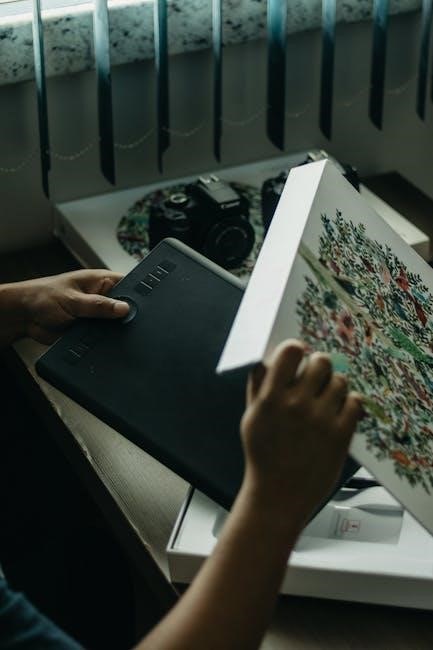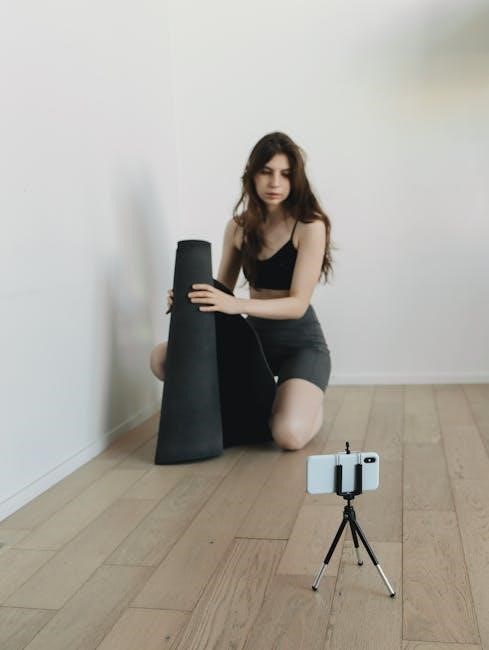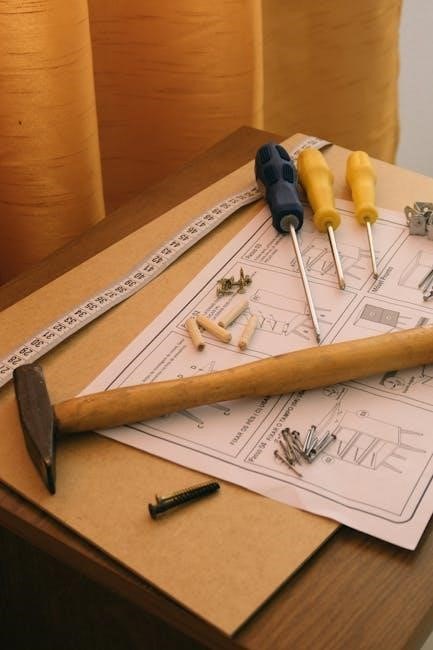The DDL 8700 7 is a 1-needle, lockstitch sewing machine designed for industrial use, featuring an automatic thread trimmer and robust construction for consistent performance in demanding environments.
1.1 Overview of the DDL 8700 7 Sewing Machine
The DDL 8700 7 is a 1-needle, lockstitch sewing machine designed for industrial use, featuring an automatic thread trimmer and robust construction. It is known for its durability and reliability, making it ideal for demanding environments. The machine offers consistent performance, stability, and efficiency, ensuring high-quality stitching for heavy-duty materials. Its sturdy design and advanced features cater to industrial settings, providing reliable operation during prolonged use.
1.2 Key Features and Benefits
The DDL 8700 7 features automatic thread trimming, enhancing productivity. Its robust construction ensures stability and consistent performance, even with heavy materials. The machine offers adjustable stitch length and sewing speed, providing flexibility. The knee lifter and presser foot lift improve fabric handling. Lubrication and maintenance features extend machine longevity. These features make it ideal for industrial settings, ensuring efficient and reliable operation for various sewing tasks.

Unboxing and Preparation
Carefully unbox and inspect the DDL 8700 7 machine for any damage, ensuring all parts and accessories are included and ready for setup.
2.1 Unboxing the DDL 8700 7
Begin by carefully opening the box and inspecting the DDL 8700 7 machine for any visible damage. Ensure all accessories, such as the knee lifter, presser foot, and thread guide, are included. Gently lift the machine, taking note of its weight and sturdy construction. Place it on a stable surface, ensuring the machine head rests securely on the provided cushions to prevent damage during unboxing.
2.2 Inspecting the Machine and Accessories
Examine the DDL 8700 7 machine for any signs of damage or defects. Verify that all accessories, such as the knee lifter, presser foot, and thread guide, are included and undamaged. Check the needle bar, thread cone, and tensioner assembly for proper alignment and condition. Ensure the machine head is securely attached to the table using rubber hinged cushions to maintain stability. Consult the manual for a detailed list of components and their proper placement.
2.3 Preparing the Workspace
Ensure the workspace is clear and well-lit for optimal sewing conditions. Secure the machine on a sturdy table, ensuring stability. Place the machine head on rubber cushions at the table’s corners for even support. Position the under cover to rest on the table groove, ensuring proper alignment. Keep essential accessories within reach. Refer to the manual for specific workspace setup recommendations to ensure efficient operation and safety.

Installation and Setup
Secure the machine head on a sturdy table using rubber cushions for stability. Attach necessary components like the knee lifter and presser foot. Ensure proper alignment and refer to the manual for detailed guidance to complete the setup correctly.
3.1 Physical Installation of the Machine
Place the machine on a sturdy table using rubber cushions for stability. Align the machine head correctly, ensuring marker line C is centered. Attach the head support rod securely to the table until it stops. Position the machine head on the cushions and ensure it is level. Follow the manual’s guidance for proper alignment and installation to prevent vibration and ensure smooth operation. Always read safety instructions before proceeding.
3.2 Connecting Electrical Components
Plug the machine into a suitable power source, ensuring the voltage matches the specifications. Connect the presser foot lifter and other electrical components as outlined in the manual. Secure all connections tightly to prevent loose wiring. Ensure the machine is properly grounded for safety. Refer to the manual for specific wiring instructions to avoid electrical hazards and ensure optimal performance.
3.3 Attaching the Knee Lifter and Presser Foot
Install the knee lifter by fitting the presser rod into the designated slot on the machine. Align the hinge with the machine bed and secure it firmly. Tighten the components until they click into place, ensuring stability. Adjust the presser foot to the desired height and align it with the needle. Test the knee lifter to ensure smooth operation. Proper installation ensures efficient sewing and prevents mechanical issues.

Threading and Thread Guide Setup
Align the thread guide marker with the screw center and gently thread the machine. Adjust the guide to ensure proper thread flow for optimal stitching.
4.1 Threading the Machine
Start by pulling the thread through the machine, ensuring it passes correctly through the tensioner and thread guide. Align marker line C on the needle bar with the screw center for proper threading. Gently guide the thread through the take-up lever and into the needle. After threading, trim any excess thread to prevent tangles. Always test the machine with a few stitches to ensure smooth operation and proper thread flow.
4.2 Adjusting the Thread Guide
Align marker line C on the needle bar with the center of the screw for proper thread guide positioning. Adjust the thread guide to ensure smooth thread flow and tension. After adjustment, test the machine with a few stitches to confirm correct alignment and operation. Proper alignment ensures consistent stitching and prevents thread issues during sewing.

Configuring Machine Settings
Configure the DDL 8700 7 by setting the stitch length, adjusting sewing speed, and configuring the presser foot lift for optimal performance and precision stitching across various materials.
5.1 Setting the Stitch Length
To set the stitch length on the DDL 8700 7, locate the stitch length control, typically a dial or electronic interface, and adjust it according to your fabric type. For heavier materials, a longer stitch length may be necessary, while lighter fabrics often require shorter stitches. Ensure the machine is set to the correct units (mm or inches) and test the stitch length on scrap fabric before sewing your final project. This step ensures optimal stitching and prevents potential issues in your work.
5.2 Adjusting the Sewing Speed
The DDL 8700 7 allows easy adjustment of sewing speed using electronic controls. You can set the speed between 1,000 to 4,000 stitches per minute, depending on the material and stitch type. For heavy fabrics, lower speeds are recommended to maintain precision, while lighter materials can handle higher speeds. Adjusting the speed ensures consistent stitching and optimal performance for various sewing tasks. Always test the speed on scrap fabric before starting your project.
5.3 Configuring the Presser Foot Lift
The presser foot lift on the DDL 8700 7 is adjusted using the knee lifter mechanism. To configure it, align the knee lifter press rod with the machine’s presser foot lift lever. Secure it firmly to ensure smooth operation. The lift height can be customized for various fabric thicknesses, allowing easier handling of heavy materials. Always test the lift mechanism on scrap fabric to ensure proper adjustment and consistent results.

Maintenance and Lubrication
Ensure regular maintenance and lubrication for the DDL 8700 7’s optimal performance. Oil mechanical parts, clean the machine, and check for wear. Refer to the manual for detailed procedures.
6.1 Routine Maintenance Checks
Regularly inspect the DDL 8700 7’s components, including the needle, bobbin, and thread guides. Check for dust buildup and lubricate moving parts as specified. Ensure the machine is clean and free from debris to maintain smooth operation. Replace worn parts promptly and verify all adjustments for consistent stitching quality. Always follow the manufacturer’s guidelines for routine checks to prevent downtime and ensure longevity.
6.2 Lubricating the Machine
Lubricate the DDL 8700 7 with high-quality sewing machine oil to ensure smooth operation. Apply oil to moving parts, such as the needle bar and thread guide, every 100 hours of use. Clean the machine thoroughly before lubrication to prevent dust buildup. Avoid over-lubrication, as it may attract debris. Regular lubrication maintains performance and extends the machine’s lifespan. Always refer to the manual for specific lubrication points and guidelines.

Troubleshooting Common Issues
The DDL 8700 7 may experience thread issues, machine noise, or needle problems. Regular checks and consulting the manual help resolve these common issues effectively.
7.1 Common Problems and Solutions
Common issues with the DDL 8700 7 include thread breakage, noise, and needle misalignment. Solutions involve checking thread guides, lubricating parts, and adjusting needle alignment. Regular maintenance can prevent these issues, ensuring smooth operation. Always refer to the manual for detailed troubleshooting steps and solutions to maintain optimal performance and extend machine longevity.
7.2 Understanding Error Messages
The DDL 8700 7 displays specific error messages to indicate issues like panel operation sounds or motor-related problems. These messages guide users to resolve issues quickly. Always refer to the manual to interpret error codes accurately. Understanding these alerts ensures proper troubleshooting and maintains smooth machine operation; Regular checks and maintenance can prevent errors, ensuring optimal performance and extending the machine’s lifespan.
Optimizing Performance
Regularly maintain the machine, adjust stitch length, and use appropriate materials to ensure smooth operation. Proper setup and lubrication enhance efficiency and extend machine lifespan.
8.1 Tips for Smooth Operation
For smooth operation, ensure proper threading and thread guide alignment. Regularly lubricate moving parts to maintain efficiency. Use appropriate materials and settings for your project. Keep the workspace organized to avoid accidents. Properly align the needle bar and knife thread guide for consistent stitching. Regular maintenance, like checking the presser foot and stitch length, ensures optimal performance and extends the machine’s lifespan.
8.2 Handling Different Materials
The DDL 8700 7 excels with various materials, from lightweight fabrics to heavy-duty textiles. For heavy-weight materials, use the DDL-8700L model, which offers enhanced stability. Adjust stitch length and presser foot lift based on material thickness. Ensure proper thread tension to prevent fabric damage. Use the knee lifter for smooth handling of bulky fabrics. Regularly check and clean the machine to maintain optimal performance across all material types.

Safety Precautions
Always read and understand safety instructions before operating the DDL 8700 7. Retain the manual for future reference and follow all guidelines carefully.
9.1 General Safety Guidelines
Ensure the machine is installed on a stable surface and properly grounded. Avoid loose clothing or long hair near moving parts. Keep children away during operation. Always disconnect the power source before maintenance. Follow the manual’s safety instructions carefully to prevent accidents. Properly handle electrical components to avoid shocks. Regularly inspect the machine for worn or damaged parts. Use protective equipment if necessary.
9.2 Emergency Procedures
In case of an emergency, immediately disconnect the power source and stop the machine. Press the emergency stop button to halt operations. Check for any obstructions or damage before restarting. Ensure all moving parts are clear and secure. If an electrical issue occurs, avoid touching components and contact a professional. Regularly inspect the machine to prevent unexpected malfunctions. Always follow the manual’s emergency guidelines to ensure safety and optimal performance;

References and Further Reading
Consult the official JUKI DDL-8700-7 Engineer’s Manual and Instruction Manual for detailed setup and maintenance guidance. Additional resources are available on ABC Sewing Machine and YouTube tutorials.
10.1 Official Manuals and Guides
The JUKI DDL-8700-7 Engineer’s Manual and Instruction Manual provide comprehensive guides for setup, maintenance, and troubleshooting. These official resources are available for download on platforms like ABC Sewing Machine and include detailed diagrams and step-by-step instructions. They are essential for understanding the machine’s operations and ensuring proper configuration and functionality.
10.2 Online Resources and Tutorials
Online platforms offer extensive resources for the DDL 8700 7 setup, including tutorials on YouTube and forums like Reddit. Websites like ABC Sewing Machine provide downloadable manuals and guides. Additionally, blogs and sewing communities share tips and troubleshooting advice, ensuring users can optimize their machine’s performance. These resources complement official manuals and are invaluable for mastering the setup process and resolving common issues efficiently.
The DDL 8700 7 setup guide ensures efficient and reliable operation, empowering users to achieve professional results. Proper setup and maintenance guarantee durability and optimal performance.
11.1 Final Checklist for Setup
- Ensure all parts are correctly installed and aligned.
- Verify the knee lifter and presser foot are securely attached.
- Check that marker line C is properly aligned with the screw center.
- Confirm the machine head is placed on cushions and rubber hinged correctly.
- Ensure the under cover is installed and resting on the table groove.
- Apply lubricating oil as specified in the manual.
- Test the machine at a low speed to ensure smooth operation.
- Review safety guidelines and emergency procedures.
11.2 Encouragement for Proper Usage
Proper usage ensures optimal performance and extends the machine’s lifespan. Always follow the setup guide and maintenance routines to maintain efficiency and reliability. Regular lubrication, correct threading, and proper needle alignment are key to seamless operation. Encourage a routine of checking and adjusting settings before use to prevent downtime. By adhering to these practices, you’ll maximize the machine’s potential and ensure safe, consistent results in your industrial sewing projects.
